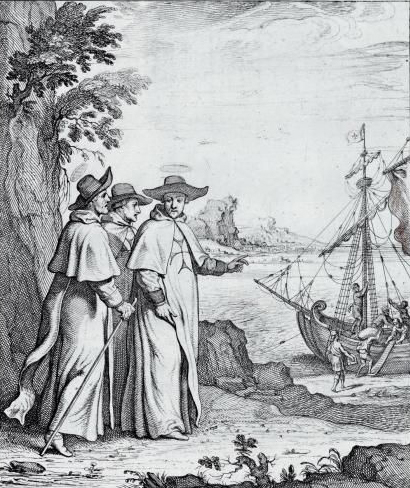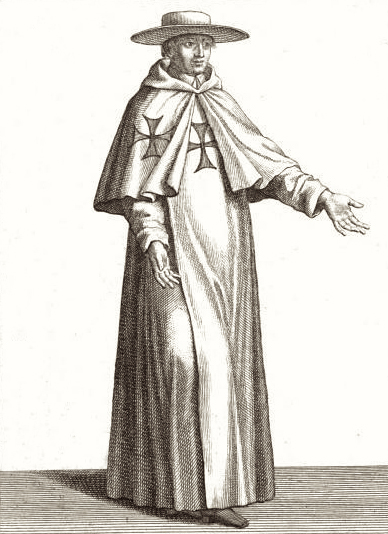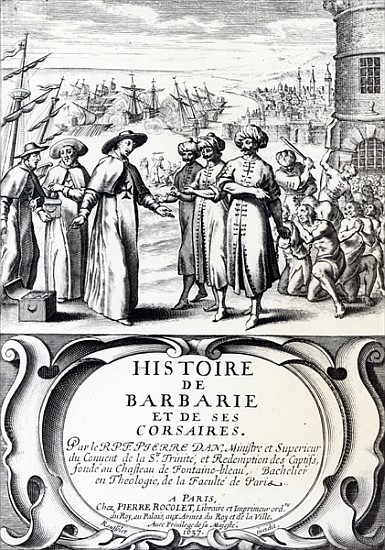Last week’s post here in this blog continued the origin story of Histoire de Babarie, the book on North African corsairs written by Father Pierre Dan, the Trinitarian friar. That post ended with Father Dan taking up the position of Father Superior at Fontainebleau, the key Trinitarian residence located at the royal residence of the French monarchs close to Paris. This week, we look at the circumstances of why and how Histoire de Babarie came to be written.
Father Pierre Dan’s Histoire de Barbarie was not conceived as a simple history of North Africa. Rather, it was an integral part of what today would be considered a sustained advertising campaign—a rebranding strategy, in fact. The Trinitarians desperately needed to revive their image in order to continue their core mission. To do this, they launched what amounted to a carefully managed public relations operation.
The ransoming/ambassadorial expedition to Algiers left in 1634, but Father Dan and his Trinitarian brothers first received notice of it in 1631. The very possibility of joining such an important mission seems to have galvanized the Trinitarians into action. Between 1631 and 1633, Louis Petit, the Father Superior of the Trinitarian Order at the time, commissioned Theodor van Thulden—a Flemish painter (one of Peter Paul Rubens’ collaborators) who was staying in Paris—to create a series of paintings depicting the lives of Jean de Matha and Félix de Valois, the two founding patriarchs of the Trinitarian Order.
These paintings disappeared during the French Revolution, but while he was in Paris, van Thulden also created a sequence of twenty-four etchings from them which were published in 1633 in a book titled Revelatio Ordinis Sanctissimae Trinitatis Redemptionis Captivorum, sub Innocetio tertio anno 1198 (The Origins of the Sacred Order of the Trinity for the Ransoming of Captives, under Pope Innocent III in 1198) which has survived in multiple copies.

The images in this book depict dramatic occasions in the lives of the saintly founders of the order. They include images of events such as Jean de Matha and Félix de Valois, both sporting haloes, receiving divine direction from an angel on high (Image 1); the two haloed men on their knees before Pope Innocent III, receiving his benediction (Image 2); the two men dressed in white Trinitarian robes (and halos), along with a third (non-haloed) companion, about to embark on a ship bound for the Barbary (Image 3); the two men (still haloed) producing bags of coins from a wooden chest and handing them over to a scowling, turbaned Muslim as payment to free a crowd of manacled captives (the illustration at the top of this post); and the those same two haloed men and their third non-haloed companion at the walls of Algiers as freed captives walk down to the harbor (Image 4).




These and the other pictures in the book are powerful, well executed images that illustrate a compelling narrative, one calculated to move viewers to awe at the divinely ordained nature of the Trinitarians’ mission, outrage at the brutal enslavement of their fellow countrymen (and women), and pity for their plight—all emotions that would have motivated people to admire, respect, and support the Trinitarian cause.
The published book containing Van Thulden’s twenty-four engravings was disseminated as widely as possible. It was followed up in 1635 by a tract titled La Rédemption des captifs faite par les religieux de l’ordre de la Sainte-Trinité, dit les Mathurins. Ensemble l’ordre de la procession d’iceux captifs faite à Paris le 20 mai 1635 (The Redemption of Captives Accomplished by the Members of the Order of the Holy Trinity, also known as the Mathurians, together with the Order of the Procession the Captives made in Paris on May 20, 1635) that describes the Tunis expedition and its triumphant march into Paris. This too was disseminated widely.
Histoire de Barbarie (the first edition of which came out in 1637) was another important part of this organized rebranding campaign. Father Dan had a mission when he wrote the book: to galvanize his readers, to make them feel righteous outrage at the cruelties of the Muslim infidels, pity for their Christian victims, and to present the Trinitarian Order in the best light possible—and in the process inspire his readers to support the newly revived Trinitarians’ saintly mission to liberate captives in North Africa.
For the modern reader, separated by nearly four hundred years from the context in which Father Dan was working, this polemical element of the book can seem rather heavy handed and intrusive (he dwells excessively on and exaggerates the negative aspects of Muslim North African culture, especially Islamic religious practices), and at times can even feel unhealthily morbid (he goes into excruciating detail about the various brutal tortures inflicted upon European captives).
Despite all this, however, there is no indication that Father Dan simply made up ugly details to shock his readers or lied about the Trinitarians’ accomplishments. Father Dan was, remember, an educated man and a scholar, and he seems to have had a scholar’s respect for the material he worked with—at least as far as he was able.
There is also no indication that Father Dan approached his polemical task cynically. He may indeed have been trying to sway his readers, but he also seems to have genuinely been moved by his experiences in North Africa and sincerely committed to the liberation of captives because it was the decent thing for a compassionate man to do.
Like people everywhere, Father Dan was a man of his times, and his writing, naturally, reflects the prevailing sentiments of the time and place in which he lived. Despite its overt polemical slant, however, Histoire de Barbarie is much more than mere propaganda for the Trinitarian cause. The wealth of detailed information Father Dan collected allowed him to deal with the geography, history, ethnography, and economics of all of North Africa. The breadth and scope of material covered results in a book that few others of its time can compete with.
All these centuries later, it still remains a generally dependable, impressively broad compendium of detailed information about Muslim North Africa in the early modern era, much of which is available nowhere else.


 The Travels of Reverend Ólafur Egilsson
The Travels of Reverend Ólafur Egilsson
The story of the Barbary corsair raid on Iceland in 1627
Amazon listing